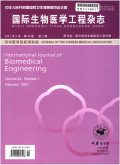脑源性神经营养因子缓释微球的制备及其通过TrkB/CREB对大鼠缺血缺氧性脑损伤的修复作用
Preparation of sustained-release microspheres of the brain-derived neurotrophic factor and its repairing effects on hypoxic-ischemic brain damage in rat via TrkB/CREB
摘要目的:探讨脑源性神经营养因子(BDNF)缓释微球的制备,及其对大鼠缺血缺氧性脑损伤的修复作用以及对酪氨酸激酶B(TrkB)/环磷腺苷效应元件结合蛋白(CREB)通路的调节作用。方法:采用乳化-溶剂挥发法和聚合物合金法制备BDNF缓释微球,通过透射电镜观察微球形态,马尔文ZS90粒度分析仪测量微球的粒径和Zeta电位,测定BDNF缓释微球的包封率和质粒载量,同时检测微球的体外缓释情况。将45只SD大鼠随机分为假手术组、模型组和治疗组,每组各15只,除假手术组外,其余2组大鼠通过结扎右侧颈总动脉和低氧环境建立缺血缺氧脑损伤模型。治疗组大鼠尾静脉注射BNDF缓释微球溶液100 mg/kg,1次/d,连续4周,假手术组和模型组大鼠尾静脉注射等量空白微球溶液。干预结束后,考察其神经功能评分、脑组织含水量和脑梗死面积、丙二醛(MDA)和超氧化物歧化酶(SOD)水平,酶联免疫吸附试验(ELISA)检测脑组织肿瘤坏死因子-α(TNF-α)和白细胞介素-6(IL-6)水平,蛋白印迹法检测脑组织BDNF、TrkB和磷酸化CREB(p-CREB)蛋白表达量。结果:BDNF缓释微球外观呈圆形或椭圆形,表面光滑,大小分布均匀,未见互相融合的微球,其粒径为(221.49±5.75)nm,Zeta电位为(?27.03±4.22)mV,包封率为(80±2)%,1 mg微球载有BDNF质粒(1.55±0.04)μg,第28天药物缓释量趋于稳定。与模型组比较,治疗组神经功能评分、脑组织含水量、脑梗死面积、MDA、TNF-α和IL-6水平均降低,SOD水平及BDNF、TrkB和p-CREB蛋白表达量均升高(均 P<0.05)。 结论:BDNF缓释微球可促进脑缺血缺氧造成的神经功能损伤修复,降低炎症反应和氧化应激反应,减轻脑水肿和脑梗死,其可能是通过激活BDNF/TrkB/CREB通路发挥作用。
更多相关知识
abstractsObjective:To investigate the preparation of sustained-release microspheres of brain-derived neurotrophic factor (BDNF) and its repairing effects on hypoxic-ischemic brain damage as well as the regulation of the tyrosine receptor kinase B (TrkB)/cAMP-response element binding protein (CREB) pathway in rats.Methods:BDNF sustained-release microspheres were prepared by emulsification-solvent evaporation method and polymer alloying method. The morphology of the microspheres was observed by a transmission electron microscope. The particle size and Zeta potential of the microspheres were measured by a Malvern ZS90 particle size analyzer, and the encapsulation rate and plasmid loading of the BDNF sustained-release microspheres were determined. The sustained release of the microspheres in vitro was also detected. A total of 45 SD rats were randomly divided into the sham-operation group, the model group, and the treatment group, with 15 rats in each group. Except for the sham-operation group, ischemic-hypoxic brain injury models were established in the other two groups by ligating the right common carotid artery and in a hypoxia environment. The rats in the treatment group were injected with 100 mg/kg of BNDF sustained-release microsphere solution via the tail vein once a day for 4 weeks, while the rats in the sham-operation group and the model group were injected with an equal amount of blank microsphere solution via the tail vein. At the end of the intervention, the neurological function scores, brain tissue water content, cerebral infarction area, malondialdehyde (MDA), and superoxide dismutase (SOD) levels were measured. The levels of tumor necrosis factor-α (TNF-α) and interleukin-6 (IL-6) were detected by enzyme-linked immunosorbent assay (ELISA). The protein expressions of BDNF, TrkB, and phosphorylated CREB (p-CREB) were detected by Western Blot. Results:The appearance of BDNF sustained-release microspheres was round or oval, with a smooth surface and uniform size distribution. No interfused microspheres were observed. The size of microspheres was (221.49 ± 5.75) nm, the Zeta potential was (?27.03 ± 4.22) mV, and the encapsulation rate was (80 ± 2) %. The microspheres (1 mg) could carry (1.55 ± 0.04) μg of BDNF plasmid, and the sustained release of the drug stabilized at day 28. Compared with the model group, the neurological function score, brain tissue water content, cerebral infarction area, MDA, TNF-α, and IL-6 levels were decreased, and the SOD level and the protein expression of BDNF, TrkB, and p-CREB were increased in the treatment group (all P < 0.05). Conclusions:BDNF sustained-release microspheres can promote the repair of neurological damage caused by cerebral ischemia and hypoxia, reduce inflammation response and oxidative stress, and alleviate cerebral edema and cerebral infarction, which may play a role by activating the BDNF/TrkB/CREB pathway.
More相关知识
- 浏览0
- 被引0
- 下载0


相似文献
- 中文期刊
- 外文期刊
- 学位论文
- 会议论文



 换一批
换一批 换一批
换一批



